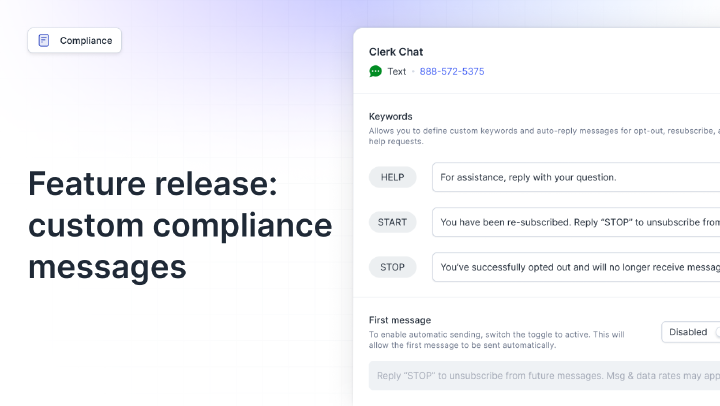The Growing Role of AI in Education to Enhance Learning and Teaching
By Team Clerk Chat
- Published: December 13, 2024
The role of AI in education is growing at an incredible rate. For years, educators have used AI-powered tools like Google Classrooms and analytical platforms to boost efficiency, enhance student experiences, and make classes more accessible.
Now, however, the rise of more advanced tech for AI in schools, such as generative and conversational AI systems, is creating more use cases and opportunities than ever before. Educators can now use AI to personalize educational resources for different learners, give every student their own AI tutor, or even improve communication between parents and teachers.
This guide explores everything from the use cases and benefits of artificial intelligence for education, to the potential challenges you’ll need to consider when starting your AI journey.
In this article:
Bring the power of AI to your school. Clerk Chat offers innovative solutions to enhance learning, improve communication, and transform education.
Learn moreThe Emerging Role of AI in Education
Next-level artificial intelligence technologies are having a profound impact on virtually every industry. In the educational landscape, however, demand for AI is growing at a particularly impressive speed. In fact, the market is currently expanding at a CAGR of 36%.
Innovators are discovering new opportunities for AI in education faster than ever. Intelligent models, with machine learning capabilities are streamlining grading processes, automating tasks for teachers, and giving them more time to spend with students.
Conversational AI technology is paving the way to better communication between caregivers and teachers and transforming customer service.
Even generative AI is giving schools intuitive ways to customize learning experiences and make class content more accessible to students with varying needs.
While there are challenges to overcome, particularly in regard to security, compliance, ethics, and privacy management, the potential for artificial intelligence in schools is phenomenal.


How Can AI Be Used in Education?
As AI systems continue to evolve, becoming more advanced, efficient, and customizable, use cases are growing. Around the world, some of the most significant use cases for AI in education include:
1. Enhancing Teacher Productivity and Efficiency
In the educational industry, AI has the potential to streamline a wide range of tasks for educators. Generative AI systems can create lesson plans and course curriculums in seconds, reducing the time spent “planning” in a school environment.
AI tools can also handle repetitive tasks like transcribing conversations between teachers and students, transforming written content into visual aids, and finding resources for lesson plans. Plus, AI tools can handle various “customer service” tasks.
For instance, AI built into an SMS customer service platform like Clerk Chat can help educators answer common parent questions, distribute information about opening and closing times, and so much more.
Already, studies from Carnegie suggest that teachers using AI reduce the time they spend on administrative tasks each day by 42% - meaning they have more time to focus on students.
2. Refining Student Assessments
While effective student assessment and grading processes do require some human oversight, AI technology in education can streamline assessment processes. There are AI tools that can rapidly grade papers based on guidelines set by teachers, saving time in the assessment process.
Just as automated messaging solutions reduce the time teachers have to spend on regular communications with parents and colleagues, automated grading tools can give educators more time to focus on personalizing the student experience.
AI systems can also offer educators invaluable insights into learning trends, and factors that affect student performance and engagement. This can help teachers to identify more effective ways of facilitating academic success.
3. Improving AI and Digital Literacy
AI solutions can help to enhance all kinds of educational experiences, but they’re particularly useful at helping educators to address the growing “digital skills gap” that exists. By integrating AI into the platforms students use every day, such as MS Teams for education, teachers enable learners to interact with these tools on a day-to-day basis.
This regular interaction can help improve digital literacy, ensure students understand the benefits of AI tools, and give them the confidence they need to embrace future innovations.
AI tools can even create courses and resources that teachers can use to educate students about concepts like ethical AI, data governance, AI app development, and more.
4. Personalizing Learning Experiences
Research suggests that individual, personalized tutoring improves student outcomes. Tutored students often outperform 98% of their peers in a traditional classroom setting. However, delivering truly “customized” learning experiences to students at scale is notoriously difficult.
Artificial intelligence in education addresses this issue. With AI, educators can tailor the learning experience to each individual. They can convert written text into visual guides, translate content into different languages, and even adapt courses to the needs of students with disabilities.
For instance, Microsoft’s Copilot can add live-captions and transcriptions to content for students with visual impairments. Beyond this, advanced AI solutions can adapt and learn from students over time. Carnegie Learning’s adaptive AI platform, for instance, customizes learning activities for students in real-time, based on their learning styles.
5. Increasing Student Engagement
Keeping students engaged is complex, but AI in education offers multiple ways to boost engagement and consequently improve learning outcomes. Aside from automatically customizing learning experiences to suit the needs of different students – improving engagement, AI solutions can help to “gamify” the educational experience.
With AI tools, educators can create immersive learning experiences and simulations that reward students as they progress, and ensure they have access to instant feedback. You could even integrate your learning management system with a tool that enables AI text messages, and trigger “congratulations” messages to arrive whenever a student achieves a specific goal.
Studies show that already 88% of the teachers who use digital games in the classroom see significant improvements in student performance.
6. Enabling Always-on Learning Support
Artificial intelligence in education isn’t about “replacing teachers” with bots. However, AI bots can help to “augment” the level of support a teacher can give to students. As educational skill shortages increase, AI bots give teachers a way to provide their students with a source of always-on support.
They can use AI tutors to give students comprehensive help with homework assignments, test preparation, and knowledge discovery. These tutors can support students around-the-clock, even when traditional teachers aren’t available.
Educators can use Clerk Chat to access text messaging services for schools which allow students to interact with a bot via text whenever they have a concern or query.
Exploring AI in Education Communication
While there are numerous potential use cases for AI in education, one of the most significant (and simple) ways for educators to leverage the benefits of AI, is by embedding it into their communication strategy.
As mentioned above, AI solutions don’t just improve communication with students by giving them access to direct feedback, guidance, and 24/7 support. AI solutions can also enhance parent-teacher communication, making it easier for caregivers and educators to collaborate on a student’s development.
Bring the power of AI to your school. Clerk Chat offers innovative solutions to enhance learning, improve communication, and transform education.
Learn moreWith a platform like Clerk Chat, for instance, educators can embed AI into their strategies for sending school text messages to parents. They can use AI-powered analytics to identify the best times to communicate with parents, and schedule text message alerts when they’ll earn the highest response rates. Educators can also use Clerk Chat’s AI features to:
- Enhance parent-teacher communication: The Clerk AI assistant can easily respond to parent queries with personalized text messages, drawing on data to deliver specific answers to questions about student grades, school opening times, and upcoming events.
- Send reminder messages: With Clerk Chat, educators can automatically send SMS appointment reminders to parents, increasing attendance at parent-teacher meetings, events, PTA sessions, and more.
- Streamline information sharing: Clerk Chat empowers educators to send mass text messages to specific cohorts about school closures, emergencies, grade results, and more.
Plus, with access to AI-driven analytics, educators can make intelligent decisions about how to improve their communication strategy going forward. Clerk Chat can even enhance team productivity, by giving educators access to an all-in-one environment for communication management.
For instance, with the Clerk Chat MS Teams SMS integration, staff members can work together in a collaborative space on all parent-teacher communication strategies, without having to jump between apps and tools.
The Benefits of Artificial Intelligence in Education
The benefits of AI in education are continuing to grow, as AI applications grow more advanced. Based on the use cases for AI in schools mentioned above, the most significant advantages of this technology include:
- Improved student experiences: AI solutions improve student experiences by personalizing educational journeys, adapting to different student needs, and offering learners access to a source of always-on support, with 2-way messaging software.
- Better learning outcomes: With more personalized, tailored learning experiences, access to more engaging “gamified” classes, and more diverse resources, students can achieve better learning outcomes, and more effectively retain knowledge.
- Greater accessibility: With AI tools that translate, transcribe, and even convert content into different formats, educators can ensure educational resources are accessible to everyone. They can even help students overcome various disabilities and learning difficulties.
- Enhanced efficiency: By automating various tasks, such as messaging parents with updates, creating lesson plans, and grading papers, AI can help teachers save time. It can make them more efficient, and productive, and give them more time to focus on students.
- Valuable insights: AI analytical tools can offer teachers and educators insights into student learning difficulties, patterns, and preferences, helping them to structure learning paths that lead to better outcomes.
- Optimized parent-teacher collaboration: With AI text messages and intelligent assistants, educators can enhance parent-teacher communications, helping improve customer satisfaction, and boost parent engagement.
AI and Education: Considerations for Schools
As AI and education become more deeply intertwined, it’s important to note there are still challenges to overcome. Studies show that although 97% of educators believe there are benefits to using artificial intelligence in education, only 35% of schools have implemented the latest technology.
There are a few reasons for this. For instance, educators are concerned about how AI might be used for plagiarism, specifically with the rise of tools like ChatGPT. They’re also concerned about the security of these tools, and how well they can protect student data.
Plus, there are ethical concerns to consider, with some teachers worrying AI tutors and tools may make their jobs obsolete. Not to mention, the technical expertise and costs associated with implementing artificial intelligence for education can make adoption difficult for many schools.
To overcome these key issues, educators will need to:
Develop AI implementation policies
Create clear policies that outline how AI should be used in the classroom or school. What tasks will you automate and enhance with AI? For instance, automating repetitive tasks like sending appointment reminder text messages to parents can be extremely useful. However, AI shouldn’t be relied upon entirely for tasks that require human creativity, empathy, and input.
For instance, you might use AI and SMS templates for customer service requests when parents and students ask basic questions, but you’ll still need to arrange one-on-one meetings when educators need to address serious performance concerns, discuss learning plans, and so on.
Consider Security, Privacy and Compliance
Before implementing AI in education, create a robust strategy for security, privacy and compliance. Consider how you’ll protect the data used to train AI bots, and train both teachers and students on using artificial intelligence correctly.
Think about how you’ll monitor your strategy for signs of security issues and threats. For instance, can you track AI bot conversations for signs of discrimination and bias? Additionally, make sure your AI tools can adapt to the compliance standards you already follow.
For instance, if you’re using SMS templates for school conversations, how can you ensure they include the right information to adhere to TCPA and CAN-SPAM guidelines? Can you ensure you schedule text message alerts to arrive outside of inappropriate hours? Can you integrate your messaging platform with archiving tools to adhere to regulations around data retention?
Start Simple with Artificial Intelligence in Education
One of the best ways to overcome the challenges of combining AI and education technology, is making sure you don’t try to do too much too fast. Choose a single “use case” you can enhance with artificial intelligence to begin with, such as improving parent-teacher communication.
Then, find a platform or tool that makes accessing AI features simple. For instance, Clerk Chat gives educators access to cutting-edge AI technologies that helps them with scheduling SMS, delivering 24/7 student and customer support, and accessing in-depth analytics.
Plus, the platform integrates directly with the tools teams already use, like Microsoft Teams, making it easier to drive adoption among staff. A slow, and measured approach to AI implementation with the right technology platform will reduce the need for extensive technical expertise, reduce adoption costs, and make it easier to measure the impact of each AI initiative.
Embracing AI in Education with Clerk Chat
Clearly, the role of AI in education is growing, introducing new opportunities to enhance teacher efficiency, student performance, communication, and educational outcomes. As AI systems become more advanced, they’ll continue to introduce new ways for educators to enhance and improve the learning experience. The key to success is knowing how to get started.
Clerk Chat offers educators an easy way to unlock the benefits of artificial intelligence for students, parents, and teachers. With intuitive solutions for messaging automation and personalization, an integrated always-on assistant, and in-depth analytics, Clerk Chat leverages AI to improve parent-teacher and student-teacher communication at scale.
How will AI help your school district?
In this article:
Ready to use your business number for text messaging?
Thousands of businesses are already experiencing the power of conversational messaging through SMS. Join us. Free trial and paid tiers available.
Get Started#Subscribe
Get product updates in your inbox
Tutorials, features, and Clerk Chat news delivered straight to you.




